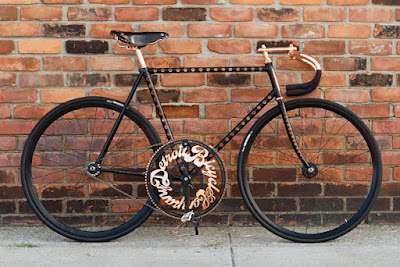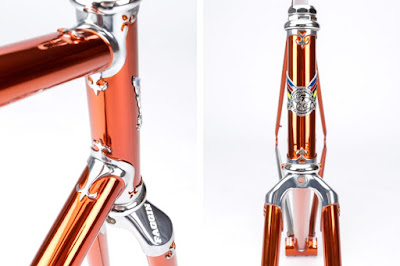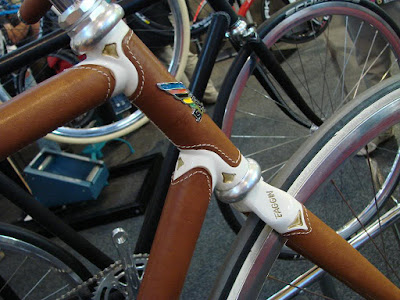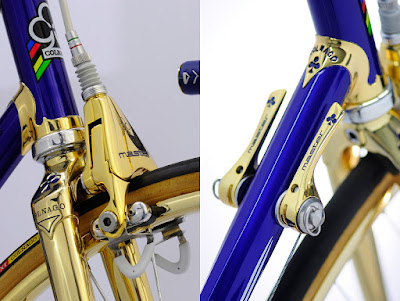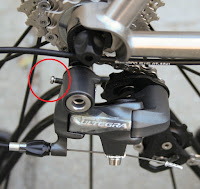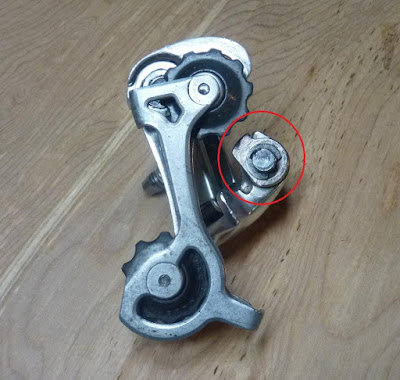Because my current projects are winding down
and there wasn’t a whole lot of news to report on them, I was trying to come up
with an interesting subject for this blog entry. During my search online to find
one or two small parts to finish off the builds, I came across some interesting
bicycles. About a year ago I featured some amazing concept bicycles, but this
time around I won’t discuss demo-type bikes you’d only find at a trade shows.
These bicycles could/can be found for purchase in manufacturer catalogs or on websites
– although most were built in limited quantities and are also VERY pricey!
I’ll start with a classic! In 2010 Wilier
Triestina re-introduced one of the most recognizable frame colors in cycling, a
copper finish as easily identified with Wilier as celeste is identified with
Bianchi. The Gioiello Ramato (copper
jewel) is a lugged steel frame with a chrome fork and chainstay in the classic
style.
Wilier indicated that the paint process used
was "faithful to the techniques that made the original ramato Wilier
famous". That beautiful copper finish was obtained through a process
called cromovelato in which copper lacquer was applied over the chrome finish -
very early Wiliers were actually copper plated according to some sources.
By the way, if you haven’t previously used
this blog to brush up on your Italian, I’ll remind you to pronounce the company
name “VEEL-ee-air”, which is an acronym for Viva
l'Italia Libera e Redenta (long live Italy, liberated and redeemed).
Steven Bock of Detroit Bicycle Company
included a 93 tooth laser-cut chainring on his Land Speed Bike, which features
a perforated frame and stem, accented in gloss black and copper. Steve has a
background in automotive show car building, but inspiration for this machine came
from a six day rider named Alfred “The Red Devil” Letourneur, who hit 108.92
mph on a Schwinn Paramount in 1941.
The next two entries come from Faggin, a
respected builder that has been around since 1945. Perhaps if you pronounce the
word “fah-GEEN”, and use a little Italian flair, the name won’t bother your
ears quite as much.
At first glance, their Fiorentino (Florentine style), with its orange cromovelato finish,
will seem like a Wilier copycat. However, a closer look will reveal distinctive
chrome lugwork that recalls the lily, or giglio (“JEE-lee-oh”) of Florence, that
is a revered symbol of the Italian city.
You might see a cyclist riding by on the
Faggin Primavera Black Edition and think
that the bike looks much like the other sleek black machines so prevalent in
the market these days. When he stops to ask where he can get a good cappuccino,
you will discover that the tubes are completely covered in stitched Italian
leather! Personally, I think the “standard” Primavera is more attractive with
tan leather and cream-colored lugs and gold-painted cut-outs, but both have a very
cool look, no matter which you prefer.
To borrow a phrase from the Retrogrouch,
“If Spiderman had a bike, he would have a Razik Vortex.” The frame combines a
latticework of carbon fiber and Kevlar that the company claims disperses
vibration like no other design. The tubing manufacturing process is not unique
to Razik - known as Isotruss, it was originally designed for NASA.
The first entry from legendary
Italian builder Colnago, the Master d’Oro, isn’t available to just anyone - unless
you have a gold-plating craftsman “on staff” - but the basic Master frameset
certainly is! I just couldn’t help including this wonderful bicycle...
However, the next Colnago beauty can be
purchased by anyone with a big enough wallet! The flamboyant Arabesque was first
produced between 1984 and 1985 to celebrate the 30th anniversary of the
company, but a 2016 interpretation of the original is now available. It has a
similar tubeshape as their mainstay Master frameset, but includes the
distinctive hand-cut lugs. Although the bike comes with modern ergo shifters, I
would want to “trick-out” the bike with some vintage downtube versions (as
pictured in second photo).
Finally, what I would consider my modern dream bike, the Look 795 Aerolight. This is the Premium Pro-team color - or
should I say couleur - that recalls
the company logo with the Piet Mondrian artwork, also known to us Yanks as “Partridge Family Bus Paintings”. The Bretagne-Séché Environnement pro
continental team didn’t exactly light the Tour de France on fire last year, but
they sure were visually fantastic riding the 795!
This bicycle is full of unique and innovative
design features too numerous to mention, so I encourage you to take a glance at
this bike show video ...
(Click the image to play - and be sure to click the full screen symbol, too!)
The (non-pro version) 795 costs nearly $15,000 – but never fear, I saw the “street model”, which lacks the electronic shifting and has traditional mechanical braking, listed on eBay for only $5600. Why not buy two?


